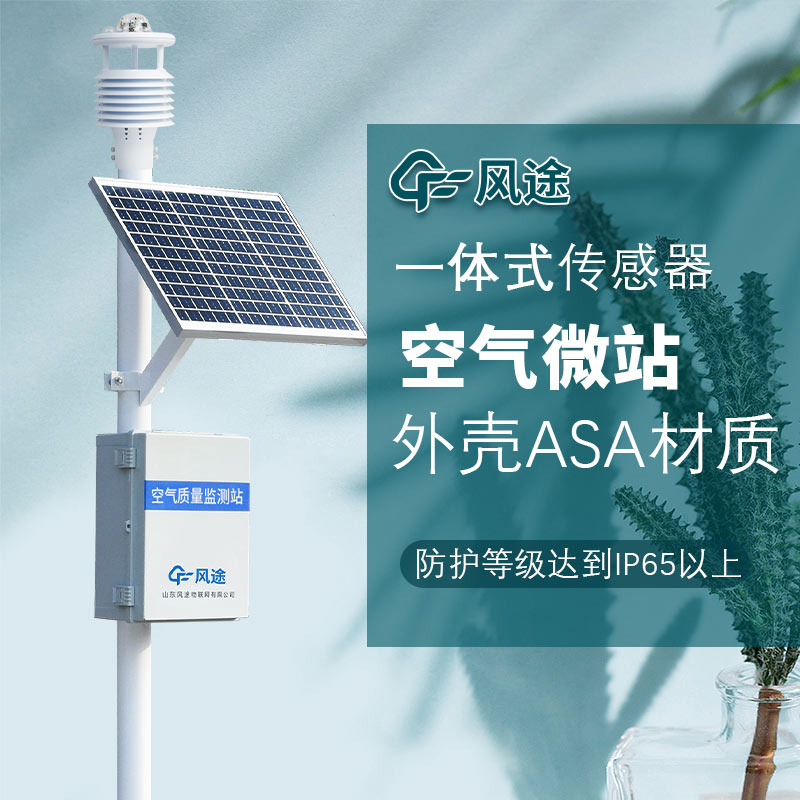Shandong Fengtu IOT Technology Co., Ltd
Sales Manager:Ms. Emily Wang
Cel,Whatsapp,Wechat:+86 15898932201
Email:info@fengtutec.com
Add:No. 155 Optoelectronic Industry Accelerator, Gaoxin District, Weifang, Shandong, China

Sales Manager:Ms. Emily Wang
Cel,Whatsapp,Wechat:+86 15898932201
Email:info@fengtutec.com
Add:No. 155 Optoelectronic Industry Accelerator, Gaoxin District, Weifang, Shandong, China
time:2025-01-13 13:48:13 source:Weather Station viewed:465 time
An air quality monitoring station is a technical system used for real - time monitoring of pollutant concentrations in the atmosphere. It can monitor air quality in real - time and give early warnings of pollution incidents. This system typically consists of sensors, data acquisition devices, data transmission systems, and data processing and analysis software.
Sensors can detect various pollutants, such as sulfur dioxide (SO₂), nitrogen dioxide (NO₂), carbon monoxide (CO), ozone (O₃), particulate matter (PM2.5, PM10), and so on.
The signals collected by the sensors are acquired and processed through a data acquisition module.
The processed data can be displayed in real - time for users to view on the instrument's display screen. It can also be transmitted to a computer or other devices for further analysis and storage through data interfaces (such as USB, RS485, etc.). There are two main data transmission methods: wired transmission and wireless transmission. Wired transmission usually uses Ethernet or RS485 bus, while wireless transmission mainly adopts wireless communication technologies such as GPRS, 3G, and 4G.
The information system platform, which is used to receive and store the automatic monitoring data of ambient air quality, communicates with the monitoring sub - stations through the network, receives the monitoring data, and can remotely control the monitoring instruments.
Compared with traditional periodic sampling monitoring, real - time monitoring can detect changes in air quality more promptly and provide support for a rapid response to pollution incidents.
When the pollutant concentration detected exceeds the preset threshold, the system will automatically issue an alarm prompt so that timely measures can be taken. This function is crucial for preventing and responding to sudden environmental incidents, as it can minimize the impact of pollution on the environment and human health.
In summary, as an important tool for environmental monitoring, the air quality monitoring station achieves real - time, comprehensive, and remote monitoring of air quality through a variety of sensor technologies and data processing technologies. It not only provides scientific decision - making basis for environmental protection departments but also provides the public with timely and accurate air quality information, helping us jointly protect the blue sky and create a healthier and more beautiful living environment. With the continuous progress of technology, the air quality monitoring station will continue to be improved and developed, playing an even greater role in the cause of environmental protection.

Dissolved oxygen refers to molecular oxygen dissolved in water, usually denoted as DO, with the unit of mg/L. It is essential for the survival of aquatic organisms. If the concentration drops below 4 mg/L, fish may suffocate to death. When it is lower than 2 mg/L, the water body enters an anaerobic...
Agricultural development will encounter some bad weather, such as typhoon, rainstorm, drought, hail, frost, etc., which will bring losses to agriculture. Setting up a meteorological and environmental monitoring system in farmland will help to improve the level of agro-meteorological environmental monitoring in the region, increase the yield of crops, and increase the ability to prevent disasters. With the development of smart agriculture, the model of weather station + Internet continues to develop, and the agricultural environment monitoring system will bring more development opportunities....
Ultrasonic wind speed sensor is a sensor used to measure wind speed, it adopts the ultrasonic principle and utilizes transmitting and receiving ultrasonic waves to measure wind speed. It consists of a transmitter, a receiver, a controller and a data processing unit. The transmitter transmits ultraso...
Duct air velocity measurement is a common operation in industrial production and environmental monitoring. Its main purpose is to monitor the flow rate of wind velocity inside a pipeline to ensure that the fluid (usually gas) inside the pipeline is within a controlled range.In industrial production,...